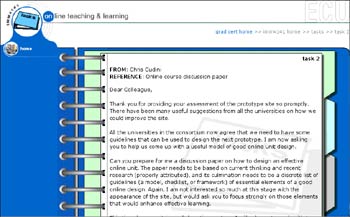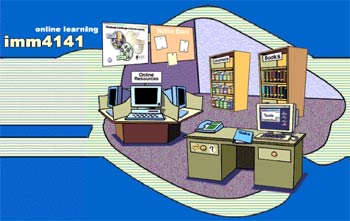Implementation Tips
- In this setting learners need to have reasonably well
developed and self-sufficient skills in ICT. Students need
to be able to access and retrieve resources from Web-based
settings, maintain and use contemporary Web browsers and
associated plug-ins to store and manipulate personal resources,
share documents among other learners, use word processors
and other productivity tools, use email and Web-based communication
systems and troubleshoot their technology if they are accessing
data from remote locations.
- Learners need to have reasonably well-developed metacognitive
skills and a capacity for self-regulated learning.
Preparing Learners
- Students need to have some generic skills associated with
the problem-solving process. This includes skills in problem
decomposition and strategy formulation.
- They need to have some experience and capability to work
with others in a team setting.
- Learners need to have some opportunity as the course commences
to recognise their needs for the learning setting and to
identify areas on which they need to work to make this learning
design effective.
Guidelines for Planning
The following pages describe the process that teachers should
follow when planning learning based on this learning design:
- Design the task first. Think about how you wish to set
up the problem into the 3 tasks.
- Once the 3 tasks have been planned, the next stage is
to choose the resources.
- With the resources chosen, the learning supports can then
be planned.
Teachers looking to employ this form of learning design should
address the following issues.
A. LEARNING TASKS
Learning Aims. The aims of the unit need
to be expressed in terms of a capability or performance. This
form of learning design does not work well in instances when
the learning aims relate to content alone. The learning aims
need to specify what students will be able to do at the end
of the course and it is these capabilities that need to guide
the selection and description of the learning tasks.
Describing outcomes in terms of a capability.
If the unit has previously involved content alone, a useful
strategy is to consider how/where students might be expected
to use this knowledge in a real-world setting. This form of
inquiry is needed to discover an appropriate context for the
learning. The focus needs to be not on learning about the
content but on learning how to meaningfully apply it. Once
the teacher has decided how this knowledge will help someone
in the workplace or in a real-world setting, selection of
the learning tasks is made easier.
Planning the tasks. The examples in this
description suggest how the tasks can be selected. It is important
to plan the tasks so that they match what actually might be
a real-life set of actions, so that one context can be used
for all three tasks, so that there is a degree of open-endedness
in the task selection enabling learners to make choices and
so that they can take ownership of what they are doing.
Defined deliverables. The tasks need to
be created so that they result in defined products whose quality
determines the scope and extent of the learning achieved.
It is useful to describe in quite clear detail what students
need to submit when tasks have been completed so that their
achievement can be assessed. Again, in relation to the authenticity,
the deliverable should be a product as one might find in a
real life setting and the criteria of its quality should be
provided in terms of the setting in which the task is cast.
(Teachers tend to provide academic criteria for assessment,
thinking about real-life success measures helps to maintain
the authentic approach).
B. LEARNING RESOURCES
Materials selections. The content and information
students need to complete the tasks are determined after the
tasks have been set. Try not to get this the other way around.
Choose the content so that students can complete the tasks
and can develop the underpinning knowledge and skills.
Instructional Independence. When creating
resources for these types of learning settings, try to avoid
the trap of creating instructional resources. With task-based
learning, the best strategy is to ensure that all the instructional
elements (your suggestions, the teacher’s directions,
etc.) are in the task specification and the suggested learning
schedule. This leaves the resources as content alone and generates
a number of advantages in terms of how you organise the resources,
being able to use them again in different places and utilising
resources from a variety of sources.
Multiple sources. In the real world, when
people seek information they tend to have to choose from among
a variety of sources. This is a sensible approach to promote
in this form of learning design. Try to include content that
provides different perspectives and which will require students
to make choices.
Avoid information overload. Too much information
and too many resources can be counterproductive. Try to avoid
too many web links and information points because this can
frustrate learners. It is often more useful to make students
seek information of their own. In this way they can stop seeking
when they have what they consider to be sufficient information.
Dynamic resources. Contemporary Web sites
have the capability to receive resources and to store them.
If students can be encouraged to contribute their products
to the course Web site, their work can have a significant
impact on the learning of others who can use them for resources,
exemplars, etc. Dynamic sites grow as the course is repeated
and helps to maintain the resources and the cycle of continuous
improvement. If students are encouraged to contribute solutions
then the problems may need to be devised in ways that can
accommodate different solutions. Alternatively, different
sets of problems may be used in subsequent implementations.
C. LEARNING SUPPORTS
Underpinning Knowledge. Learning in task-based
modes does not mean that learners have to discover the content
or underpinning knowledge for themselves. It is very important
to ensure that the learners are guided in their approaches
by the existing knowledge. A way to ensure this is to provide
a suggested learning pathway that highlights the information
that you think should guide their actions and their decision
making.
Collaborative Learning. A very strong support
for student learning is the process of working collaboratively
with others. Students will need to be guided as to how they
might collaborate in meaningful and efficient ways.
Workplace Mentors. Many students .who undertake
e-learning have workplace jobs and these can be used as strong
supports for learning. If the tasks are created in an appropriate
fashion, learners can be encouraged to undertake tasks at
the workplace and with the support of their line managers
and peers. These people can provide substantial support for
this form of learning design and assist the learning process
in a number of ways.
Online Discussions. Online learners expect
to be involved in online discussions where ideas are viewed
and debated. Try to ensure that the discussions you plan have
direct relevance to the task and that learners are aided in
their task completion through participation in the discussion
activity. It is important for learners to see relevance in
these activities and to see reasons for participation that
are related to the learning outcomes sought and the product(s)
being developed.
Learning Pathways and Schedules. One of
the big problems with learning designs like this is that learners
often are discouraged by the open-ended nature and the size
of the task that confronts them. The provision of a learning
schedule as a guide is a strong scaffold that learners can
fall back on if they are overwhelmed and that can provide
them with guidance to proceed.
Recognise Individual Differences. Learners
come to the class with differing backgrounds and experiences.
Providing degrees of openness to the tasks enables those with
significant previous experience to avoid having to wade through
materials and resources with which they are already familiar.
On the other hand some learners will want teacher help so
there must be supports for learners with minimal backgrounds
so that the completion of the tasks is within their realms
of possibility.
Learning Diaries. Learning diaries are personal
reflection spaces that learners can be encouraged to establish
and maintain as support for their metacognition and self-regulated
learning development. The provision and use of electronic
diaries also enables the teacher to gain insights into problems
and difficulties learners may be having and facilitate proactive
actions on the part of the teacher to overcome these.
Guidelines for the Tutor/Facilitator
Any teacher/tutors implementing this form of learning design
will need to have some skills in teaching online and these
skills can be obtained from a variety of sources. The forms
of e-learning skills that delivery in a course of this form
will require include:
An ability to moderate online discussions.
Online discussions form an integral component of elearning
and tutors need to be able to manage the discussion boards
in ways which encourage involvement and maintain student interest.
Learning communities. Teachers need to be
able to support the development of learning communities among
the learners in the class. The development of learning communities
is a task which teachers in most online settings seek to achieve.
There is a substantial body of literature which can guide
teachers in their actions in this aspect of online delivery.
It is a skill which develops with experience but which is
aided by appropriate use of discussion boards, the establishment
of collaborative groupings within the class, encouragement
of open discussion and respect for fellow learners, the sharing
of information and ideas help to develop a sense of community
among participants.
Appropriate feedback. This form of learning
setting can involve protracted periods of time when learners
are working without direct feedback from tutors. It is important
to include processes and procedures that will enable student
activity and progress to be monitored so that potential problems
caused by the teacher-student distance can be pre-empted and
minimised.
Proactive involvement. This learning design
is student-centred and is based on empowering the learners
and giving them some degrees of independence from their teachers.
An important part of the teacher/tutor role is to respect
this independence but to be available and interested. This
requires proactive activities on the teacher's part but activities
that encourage and support rather than demand in helping students
to keep to deadlines, meeting requirements, collaborating
with peers, seeking feedback etc.
|

